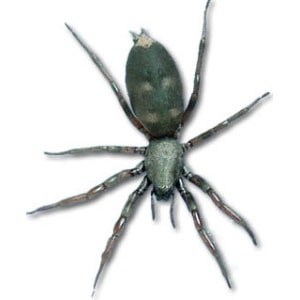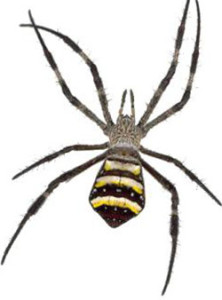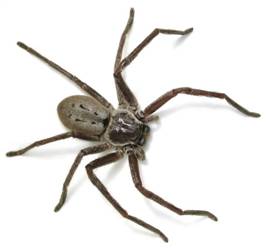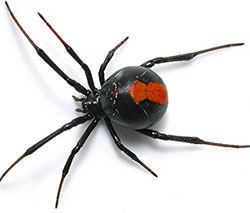Pest Control Endeavour Hills: Mice Infestation
In winter, the chances of rodents entering your home are at their highest, while also making it the busiest period for us at Pest Control Endeavour... Read More
Call Us Now
0438 292 477
03 9705 8323
 DESCRIPTION: White-tailed (or white-tipped) spiders have a dull black, elongate body with a distinctive white spot at the end of the abdomen.
DESCRIPTION: White-tailed (or white-tipped) spiders have a dull black, elongate body with a distinctive white spot at the end of the abdomen.
Females have a plump abdomen and grow up to 20 mm long, while males are thinner and grow to about 12 mm long.
Adult white-tailed spiders have reddish legs and two pairs of faint white spots on the top of the abdomen. Young spiders have striped legs with more distinct white spots which fade with age.
White-tailed spiders are found in southern Australia including Tasmania. They are commonly found in homes and other buildings, although their natural habitat is under rocks, fallen timber and bark in gardens and bushland.
BITE: Most victims suffer only localised pain, redness and swelling which may last from a few hours to a few days, although in some cases the symptoms are more severe.
FOUND: White-tails will shelter under almost anything including clothes left on the floor overnight and bed coverings, a habit which gives rise to frequent bites. Avoid leaving clothes on the floor, and check under bed coverings before getting into bed.
WEB: White-tailed spiders do not build a web but wander in search of prey.
 DESCRIPTION: St Andrew’s Cross Spiders are named for their bright web decorations – zig-zag ribbons of bluish-white silk that form a full or partial cross through the centre of the orb web. Females have a silvery carapace and a silver, yellow, red and black banded upper abdomen with two longitudinal yellow stripes below. The spider sits with the legs in pairs. The brown and cream coloured males are smaller than females.
DESCRIPTION: St Andrew’s Cross Spiders are named for their bright web decorations – zig-zag ribbons of bluish-white silk that form a full or partial cross through the centre of the orb web. Females have a silvery carapace and a silver, yellow, red and black banded upper abdomen with two longitudinal yellow stripes below. The spider sits with the legs in pairs. The brown and cream coloured males are smaller than females.
The cream-coloured young spiders make a circular stabilimentum (like a white silk doily) that disguises them well and may also act as a sunshade. As the spider grows the ‘doily’ is gradually transformed into a ‘cross’.
BITE: the bite is considered harmless but can cause a weak local reaction.
WEB: The average orb web is practically invisible, and it is easy to blunder into one and end up covered with a sticky web. The very easily visible pattern of banded silk made by Argiope is pure white, and some species make an “X” form, or a zigzag type of web (often with a hollow centre). The spider then aligns one pair of its legs with each of the four lines in the hollow “X”, making a complete “X” of white lines with a very eye-catching spider coloured bright yellow on a field of black or variegated red white and yellow stripes forming its centre. The white patterns are called stabilimentum and reflect UV light. They have been shown to play a role in attracting prey to the web, and possibly to prevent its destruction by large animals. The centres of their large webs are often just under 1 metre above the ground, so they are too low for anything much larger than a rabbit to walk under. The overtness of the spider and its web thus has been speculated to prevent larger creatures from accidentally destroying the web and possibly crushing the spider underfoot.
Other studies suggest that the stabilimenta may actually lead predators to the spider; species such asA. keyserlingi place their web predominantly in closed, complex habitats such as among sedges. As Argiope sit in the centre of their web during the day, they have developed several responses to predators, such as dropping off the web, retreating to the periphery of the web, or even rapidly pumping the web in bursts of up to 30 seconds.
 DESCRIPTION: Badge huntsman spiders are large, long-legged spiders. They are usually fawn or grey on top, with distinctive colour combinations of black, white, orange or yellow under the abdomen (the ‘badge’) and colour bands on the underside of the front legs. Most huntsman spiders have flattened bodies adapted for living in narrow spaces under loose bark or rock crevices. This is aided by their legs which, instead of bending vertically in relation to the body, have the joints twisted so that they spread out forwards and laterally in crab-like fashion (‘giant crab spiders’). Badge Huntsman spiders (Neosparassus) have less flattened bodies.
DESCRIPTION: Badge huntsman spiders are large, long-legged spiders. They are usually fawn or grey on top, with distinctive colour combinations of black, white, orange or yellow under the abdomen (the ‘badge’) and colour bands on the underside of the front legs. Most huntsman spiders have flattened bodies adapted for living in narrow spaces under loose bark or rock crevices. This is aided by their legs which, instead of bending vertically in relation to the body, have the joints twisted so that they spread out forwards and laterally in crab-like fashion (‘giant crab spiders’). Badge Huntsman spiders (Neosparassus) have less flattened bodies.
BITE: Badge Huntsman have been known to bite and general symptoms include local severe pain and swelling, sweating, nausea and vomiting. A cold pack may relieve local pain. Seek medical attention if symptoms persist.
WEB: They do not build a web.
 DESCRIPTION: Dark, robust spider, the female growing up to 18mm, with a 30mm legspan. As with most spiders, the males are smaller (10mm), and have longer legs in relation to their body size. In both sexes the carapace and legs are dark brown to black, and the abdomen is charcoal grey with a dorsal pattern of light markings (sometimes indistinct) and a dense covering of fine, velvety hair. B. longinquus is slightly smaller (14mm) with a greyish carapace and red-brown legs.
DESCRIPTION: Dark, robust spider, the female growing up to 18mm, with a 30mm legspan. As with most spiders, the males are smaller (10mm), and have longer legs in relation to their body size. In both sexes the carapace and legs are dark brown to black, and the abdomen is charcoal grey with a dorsal pattern of light markings (sometimes indistinct) and a dense covering of fine, velvety hair. B. longinquus is slightly smaller (14mm) with a greyish carapace and red-brown legs.
BITE: Due to its timid nature this spider rarely bites humans,however the bite can cause general symptoms including nausea, sweating,localised pain and swelling.
WEB: Lacy sheet with one or two funnel shaped entrances leading into a tubular retreat.
 FOUND: Indoors in dark places such as furniture and cupboards outdoors, they can be found in sheds, plant pots and around general Items around the house.
FOUND: Indoors in dark places such as furniture and cupboards outdoors, they can be found in sheds, plant pots and around general Items around the house.
BITE: Not lethal, but may cause nausea or headaches and small blisters around the bite.
WEB: They have a tangled web with sticky catching attached to substrate.
 DESCRIPTION: The female redback has a round body about the size of a large pea (1 centimetre long), with long, slender legs. The body is a deep black colour (occasionally brownish), often containing an obvious orange to red longitudinal stripe on the upper abdomen. The stripe is sometimes broken or looks like small red dots. On the underside of the abdomen there is an “hourglass” shaped red/orange spot. Juvenile spiders have additional white markings on the abdomen. The male redback is three to four millimetres long and is light brown in colour with white markings on the upper side of the abdomen and a pale hour-glass marking on the underside.
DESCRIPTION: The female redback has a round body about the size of a large pea (1 centimetre long), with long, slender legs. The body is a deep black colour (occasionally brownish), often containing an obvious orange to red longitudinal stripe on the upper abdomen. The stripe is sometimes broken or looks like small red dots. On the underside of the abdomen there is an “hourglass” shaped red/orange spot. Juvenile spiders have additional white markings on the abdomen. The male redback is three to four millimetres long and is light brown in colour with white markings on the upper side of the abdomen and a pale hour-glass marking on the underside.
FOUND: Outdoor around rubbish,litter,old paint cans/tins, under verandahs, seats, rocks and weep holes.
BITE: Highly venomous and symptoms that include nausea, vomiting, convulsions etc.
WEB: Tangled web with sticky catching attached to substrate.
If you have any more questions or problems with pest control, feel free to contact us today!
